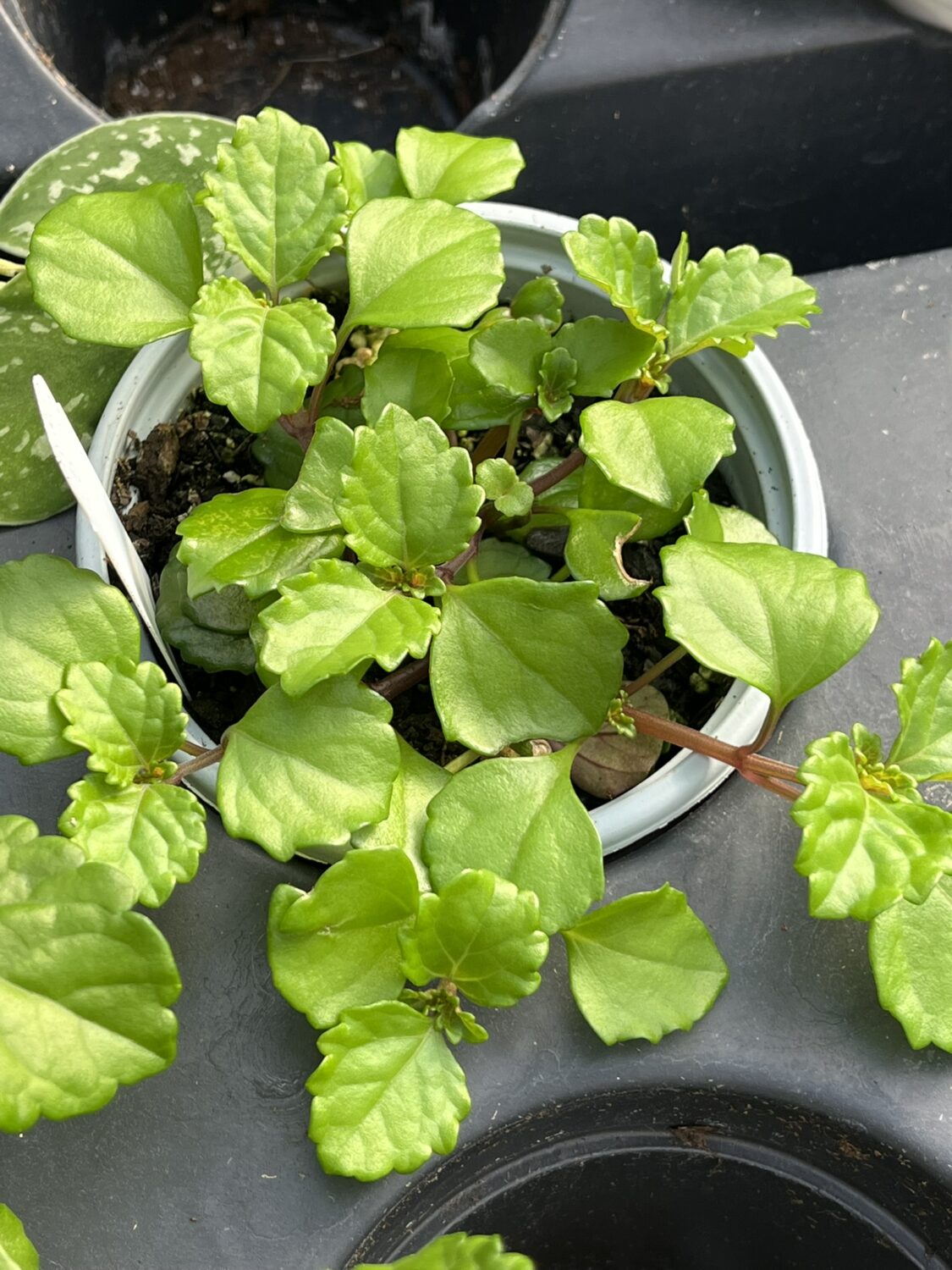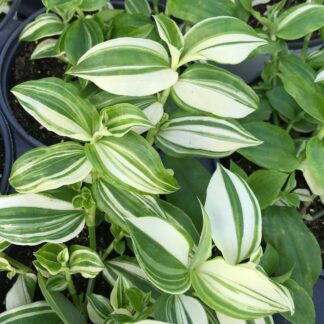Description
The Complete Guide to Plectranthus verticillatus: Swedish Ivy Care Made Easy
Welcome to the wonderful world of Swedish Ivy!
Plectranthus verticillatus, lovingly known as Swedish Ivy, is one of those houseplants that makes you smile just by looking at it. Its bright green, scalloped leaves tumble over the edges of pots, catching the light with their glossy finish. It’s lush, it’s lively, and it’s incredibly easy to grow—even if you’ve never kept a plant alive before.
But here’s the funny part: Swedish Ivy isn’t from Sweden at all! It actually comes from the warm, breezy landscapes of South Africa. So how did it get its name? We’ll get to that in a bit. First, let’s explore why so many plant lovers (myself included!) keep coming back to this lovely trailing plant—and how you can grow it effortlessly in your own home.
Why You’ll Love Swedish Ivy
Let’s start with the basics. Swedish Ivy is a trailing perennial, which means it keeps growing year after year and has long stems that love to spill out of baskets or creep across tabletops. The leaves are rounded, glossy, and scalloped, like tiny green waves, and the plant occasionally pops out delicate lavender or white flowers.
But most of all? It’s so easy to care for.
This is a “set it and forget it” kind of plant. Great for beginners. Great for busy people. Great for anyone who wants something beautiful without all the fuss.
Getting to Know Swedish Ivy
Botanical name: Plectranthus verticillatus
Common name: Swedish Ivy
Origin: South Africa (not Sweden!)
Plant type: Trailing perennial
Light needs: Bright, indirect light
Pet safe? Yes—generally considered non-toxic to pets!
How to Grow and Care for Swedish Ivy
Ready to dive in? Let’s break down everything you need to know about planting, growing, and keeping your Swedish Ivy happy and healthy.
🌱 1. Planting & Propagation
Swedish Ivy is famous for how easy it is to propagate. That’s just a fancy way of saying you can snip off a piece and grow a whole new plant!
How to Propagate:
-
Take a cutting from a healthy stem—around 4 to 6 inches long.
-
Remove the bottom leaves so at least one node (a little bump where the leaf came off) is showing.
-
Place the cutting in water or moist potting soil.
-
If using water, keep the node under the surface and put the jar in bright, indirect light.
-
Roots should appear in 1 to 2 weeks. Once they do, move it to a pot with soil if needed.
This is a fun project to do with kids or share with friends!
🌞 2. Light Requirements
Swedish Ivy loves bright but indirect sunlight. It’s flexible, though. It will still grow in medium light, just a little slower.
-
Indoors: A spot near an east- or north-facing window is perfect.
-
South- or west-facing? Just use a sheer curtain so the light isn’t too strong.
-
Outdoors: Keep it in the shade or filtered light. Too much sun can scorch the leaves.
If the plant starts to look long and leggy, it probably needs more light.
🪴 3. Soil Needs
Think “light and airy” when it comes to soil. Swedish Ivy likes soil that drains well but also holds a bit of moisture.
Best Soil Mix:
-
2 parts potting soil
-
1 part perlite or coarse sand (for drainage)
-
1 part coconut coir or peat moss (for moisture)
This mix helps the roots breathe and grow strong.
💧 4. Watering the Right Way
Watering is simple with Swedish Ivy—but it’s important to get it right.
Here’s how:
-
Stick your finger into the soil. If the top inch feels dry, it’s time to water.
-
Water more during spring and summer, when the plant is actively growing.
-
Cut back in fall and winter, when the plant slows down.
-
Always use pots with drainage holes.
Yellow leaves? That could mean overwatering.
Droopy or crispy leaves? It might be thirsty.
🌡️ 5. Temperature & Humidity
Swedish Ivy likes it warm and a little humid—just like its native South African habitat.
-
Ideal temp: 60–75°F (16–24°C)
-
Don’t let it drop below 50°F (10°C)
-
Loves moderate to high humidity
You don’t need a rainforest in your living room, but misting the leaves or using a pebble tray with water can help in drier homes.
🌿 6. Fertilizing for Full, Lush Growth
This plant doesn’t need much food, but a little can go a long way during growing season.
Fertilizer tips:
-
Use a balanced, water-soluble fertilizer at half strength.
-
Feed every 4–6 weeks in spring and summer.
-
Stop feeding in fall and winter—let the plant rest.
And don’t forget: flush the soil every few months to wash away leftover salts from the fertilizer.
✂️ 7. Pruning and Maintenance
Want a full, bushy plant? Pinch the tips! Seriously.
Pruning helps the plant stay tidy, grow fuller, and live longer.
What to do:
-
Pinch or trim back long stems.
-
Snip off any yellow, wilted, or dead leaves.
-
Use clean scissors to avoid spreading any disease.
Bonus: every time you prune, you can use the cuttings to grow new plants!
🐛 8. Pests and Diseases
Swedish Ivy is usually trouble-free. But like all houseplants, it can sometimes get pests.
Common ones:
-
Spider mites
-
Aphids
-
Mealybugs
Look for: sticky spots, tiny webs, or curled leaves.
What to do:
-
Wipe the leaves with a damp cloth.
-
Spray with mild soapy water.
-
Use neem oil or insecticidal soap if pests keep coming back.
To avoid fungal problems, don’t let the plant sit in soggy soil, and make sure it gets good air flow.
🌱 9. Repotting Swedish Ivy
Your Swedish Ivy grows fast! Every 1–2 years, it will need a new pot.
Steps:
-
Choose a pot that’s just a little bigger—1–2 inches wider.
-
Gently remove the plant and shake off the old soil.
-
Check the roots. Cut away any that look brown or mushy.
-
Replant with fresh soil, keeping the base of the plant just above the soil line.
-
Water lightly after repotting to help it settle in.
Repotting is also a great chance to refresh the soil and remove any salt buildup.
🌟 10. Extra Tips for Success
Here are a few extra care tricks that can make a big difference:
-
Rotate the pot once a week so the plant grows evenly on all sides.
-
Dust the leaves every few weeks. Clean leaves = better photosynthesis = happier plant!
-
If you keep your Swedish Ivy outside in summer, bring it in when it gets cool. It’s not frost-tolerant.
A Plant That Grows with You
What I love most about Swedish Ivy is how generous it is.
It grows quickly. It shares easily. And it forgives your mistakes.
You can clip off a piece, root it in water, and give it away as a gift. Or you can just enjoy it for yourself—watching it spill over the sides of your pot like a green waterfall. It’s a simple way to bring life into your space.
And maybe best of all? It doesn’t need much from you—just a little love and a sunny windowsill.
So, Why Is It Called “Swedish Ivy” Anyway?
The name is a bit of a mystery, but here’s the most popular theory: The plant became a favorite in Swedish homes during the 19th and 20th centuries. Its tidy habit, fast growth, and easy care made it perfect for hanging baskets in bright Scandinavian windows. So while it isn’t from Sweden, it found a second home there.
Let’s Recap! Quick Care Checklist
✅ Bright, indirect light
✅ Water when top inch of soil is dry
✅ Light, airy soil with good drainage
✅ Moderate warmth and humidity
✅ Pinch stems to keep bushy
✅ Easy to propagate from cuttings
✅ Repot every year or two
✅ Dust the leaves and rotate regularly
✅ Watch for pests, but don’t worry too much!
Whether you’re just starting your plant journey or looking for something lovely to add to your indoor jungle, Swedish Ivy is a plant that grows with you. It brings joy, ease, and that touch of green magic we all need a little more of.
Go ahead—give it a try. This plant is ready to thrive right alongside you. 🌿💚





